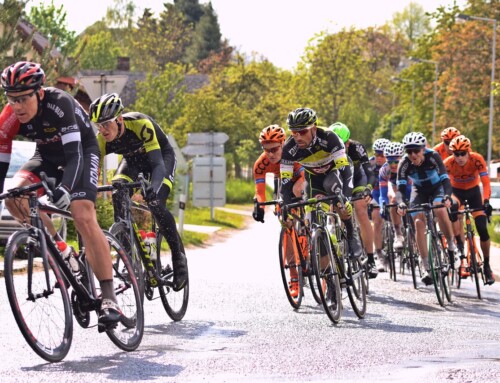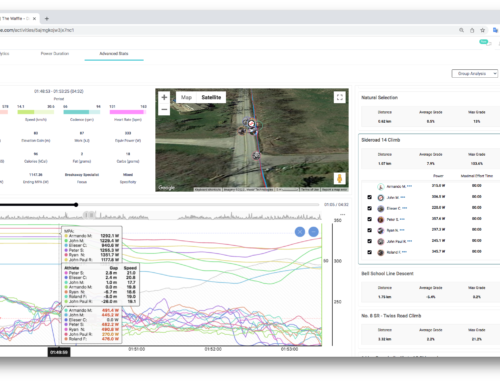Fitness Testing
Most athletes dread test days. These are the days in your training plan where you test your fitness to see where you stand: “Am I improving?”, “Do I need to change to workout targets?”. They are dreaded because they require a lot of motivation. Your FTP can fluctuate 30-40 watts during the season and having a good estimate could mean the difference between a successful or a failed workout.
To test your FTP, the recommended method is to do a long time-trial effort, perhaps as long as an hour. Unfortunately, the mental and physical preparedness one has to achieve for this test prevents many from attempting it, let alone successively completing it. A more common method is to do “The 20-minute FTP Test”. These too are not easy as they require the right pacing and execution planning. Go out too hard, and the test is abandoned too early. Go out too easy, and you don’t put out a number that represents what you can do. Some are now advocating for an 8-minute test. These too are very difficult, especially that two of these tests are done in sequence. In each of these cases, your FTP is only roughly estimated using a fraction of the power you were able to sustain for the test.
“Throughout this hour, the longest of my career, I never knew a moment of weakness, but the effort needed was never easy. It’s not possible to compare the Hour with a time trial on the road. Here it’s not possible to ease up, to change gears or the rhythm. The Hour record demands a total effort, permanent and intense, one that’s not possible to compare to any other. I will never try it again.”
Eddy Merckx
MPA Analysis and Fitness Signature Extraction
Xert takes a very different approach in establishing your fitness numbers. By analyzing your regular activity data and performing MPA Analysis, your Fitness Signature can be extracted from the data. This includes not just your Threshold Power, but also your High Intensity Energy and your Peak Power too – all three of which define your individual power profile. Fitness Signature extraction establishes your fitness by identifying those maximal efforts in your activity and uses a regression algorithm to determine a fitness signature that matches these points. You’ll find that whether you perform a specific test or whether you use a club ride, if the power data includes time spent doing a maximal effort, Xert can extract your signature. For example, take this 20 minute FTP test data:
 You can see that the athlete’s MPA (blue line) starts at their peak power and slowly moves down until it reaches the power output (red line) at precisely the point that the athlete’s gives up (green diamond). The fitness signature that is representative of the athlete’s fitness signature at the time of this test is displayed at the bottom: Threshold Power = 328W, High Intensity Energy = 32.7kJ and Peak Power = 1460W. This same athlete also entered a local criterium, where their fitness was put to the test. Here is an MPA chart of the race. Where MPA dips towards the athlete’s power and eventually meets the athlete’s power, is representative of a point of maximal effort:
You can see that the athlete’s MPA (blue line) starts at their peak power and slowly moves down until it reaches the power output (red line) at precisely the point that the athlete’s gives up (green diamond). The fitness signature that is representative of the athlete’s fitness signature at the time of this test is displayed at the bottom: Threshold Power = 328W, High Intensity Energy = 32.7kJ and Peak Power = 1460W. This same athlete also entered a local criterium, where their fitness was put to the test. Here is an MPA chart of the race. Where MPA dips towards the athlete’s power and eventually meets the athlete’s power, is representative of a point of maximal effort:
 If we zoom in to this section:
If we zoom in to this section:
 You can see that athlete was close to MPA for quite some time. This was a tough race for them. At the moment their power reaches MPA, they get dropped. Signature extraction for this race data is shown below the chart. It is representative of their fitness at the time of the race and it is the same as the fitness signature from the 20 minute test.
You can see that athlete was close to MPA for quite some time. This was a tough race for them. At the moment their power reaches MPA, they get dropped. Signature extraction for this race data is shown below the chart. It is representative of their fitness at the time of the race and it is the same as the fitness signature from the 20 minute test.
Using Regular Activity Data for Signature Extraction
Xert enables you to upload your activity data and will perform signature extraction automatically when you upload your ride. This process determines your fitness signature parameters – Threshold Power, High Intensity Energy and Peak Power at the time of the activity. The key benefits to using Xert for fitness testing are as follows:
- Use regular activity data that contain maximal efforts;
- Avoid having to know in advance what your fitness numbers are in order to set your pace;
- This is especially useful if you are new to training with power data.
- Use variable efforts, including those containing periods of rest;
- Conduct your tests in a shorter amount of time;
- Obtain your Threshold Power and your Peak Power and High Intensity Energy;
- Test more often, even at the end of rides;
- Test before an event to know your numbers and confirm the event strategy;
- Avoid testing altogether if your regular training/group activities include time spent at maximal effort.
A Simple Xert Test Protocol
If you wish to conduct a specific workout to test for your entire fitness profile, i.e. establish your current fitness signature, this simple and fun process works great:
- Warmup – This can be done in anyway you prefer, including a hard effort or two. Being fresh , i.e. having no fatigue, before starting the test isn’t a requirement;
- Generate fatigue – You want to lower MPA. If you are using Xert Mobile or Xert MPA and Power for ConnectIQ, bring MPA down to about 400W above Threshold Power. Give yourself moments of rest if needed;
- Do a maximal effort – This is the toughest part. Be sure to execute this well. Choose a slight uphill and with good speed, gear down go as hard as you can out of the saddle. Avoid needing to change gears in the middle of it;
- Briefly rest and repeat if you wish to make sure you have your best result;
- Rest for 10 minutes or until MPA is restored to Peak Power;
- Do 4 or 5 out-of-the-saddle peak power sprints. Execution is important as you want you to put out your highest power possible. Do short 5-7 second bursts with a couple of minutes of rest in between to ensure you’re recovered. It is important that you post a good number that represents something near your peak power. On your last sprint, go all out for 20 seconds or so;
- Upload to Xert Online;
- Open the Activity Details to review your fitness numbers.






